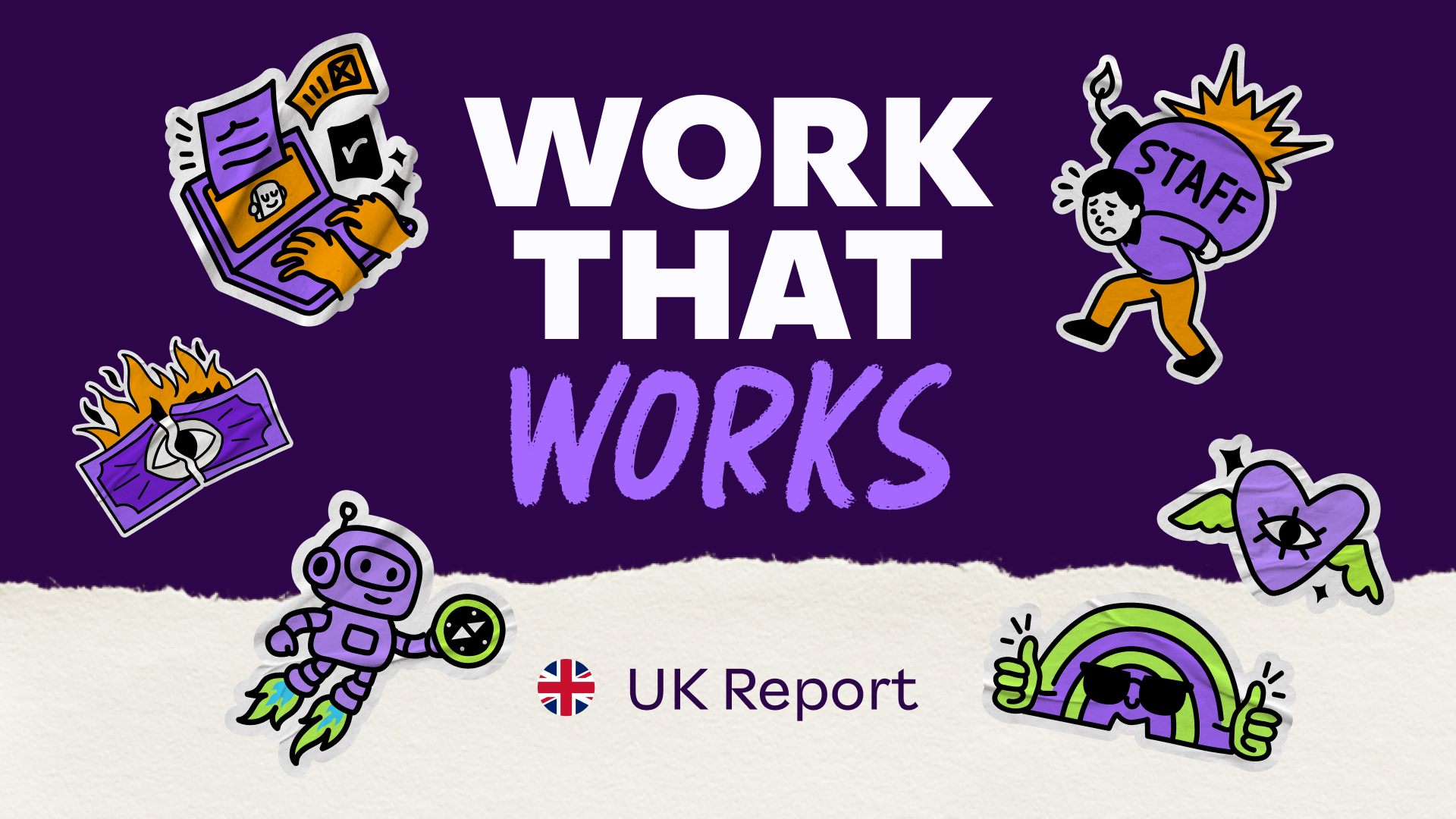360 Degree Review Template [Free Download]
Published
360 Degree Review Template [Free Download]
2 min read
Feedback is a valuable tool for professional development. Whether you’re at the start of your career or a seasoned leader, there’s always room to learn. That’s why businesses need to embrace many types of feedback beyond traditional performance reviews, from quick check-ins to 360-degree (360°) reviews. 360° reviews aren’t used as widely in the world of business when compared to the standard end-of-year performance review, but they can be a fantastic method of feedback.
Unlike conventional feedback, they aren’t dictated by a chain of command – that is to say, in these reviews, reports can also review their manager, or peers can review their colleagues. Feedback should come from a variety of sources from all levels of the company. These kinds of reviews have been widely used at leading international companies, including Google. However, you don’t need endless company resources to see their benefits.
They also align closely with strong company values, building a culture where performance feedback is routine, expected, and constructive. By encouraging employees to communicate openly and seek feedback from their peers, leaders, and reports, 360° reviews support a more transparent and growth-oriented workplace. Give 360° reviews a go with your team today, starting with our downloadable review template.
What is a 360 degree review template?
A 360° template acts as a survey for gathering feedback on employee performance at work. When distributed to those giving feedback, team members can answer questions in relation to the individual they’re reviewing.
How do you use this 360° feedback template?
This template is designed as a clear feedback form, to solicit feedback about an individual at work. Ideally you would send several copies of this template via email to different team members with a knowledge of the individual’s work performance. For example, they could be someone who worked on a project with the individual, their line manager or a direct report.
Once the responses have been noted on the copies of this template, you can collect them and then the individual who has been reviewed can go through the results with a HR professional or their manager. Remember to repeat the feedback process in cycles, so you can track progress and see whether the feedback has been acted upon.
This template has been designed with multiple-choice questions and identical responses, which you can collate into simple, measurable statistics. There’s also open-ended questions for more detailed written answers. Download your copy today and save them for your next round of 360 degree reviews.
Our template can also help you identify areas where employees excel in problem solving, collaboration on team projects, and their ability to meet deadlines. When peer feedback and relevant feedback is collected in a structured way, it becomes easier to develop tailored support such as a personal development plan.
How to run a 360° feedback review
If you’re looking to implement a full 360° review process, here’s a simple framework you can follow:
- Define goals and competencies
Start by identifying what you want to measure, such as leadership, communication, or accountability. Align these competencies with your company values and role expectations. - Choose participants
Include 3–7 people from across the organisation. These can be peers, managers, direct reports, or even clients. Aim for diversity in feedback. - Include a self-assessment
Give the person being reviewed the chance to reflect on their own performance. This helps with buy-in and comparison. - Distribute surveys (digitally if possible)
Send out the forms or use a feedback tool to collect input. Ensure anonymous feedback options to encourage honesty. - Collate and analyse responses
Use simple tools or built-in analytics to collect feedback and look for patterns in ratings and comments. Filter extremes and identify trends. - Schedule a feedback review meeting
A supportive manager should facilitate the conversation, helping the employee understand the results and provide any necessary guidance. - Create a personal development plan
Use insights to set SMART goals, reinforce strengths, and tackle development areas. The manager should support this through regular coaching. - Follow up
Set calendar reminders to revisit goals, provide support, and celebrate improvements. Keep the loop going.
Examples of feedback questions
The strength of a 360° review lies in the quality of the questions you ask. Thoughtfully worded prompts helps to give reviewers relevant feedback that highlights both strengths and areas for personal development. Whether you’re evaluating employees, peers or managers, your questions should align with your organisation’s company values, role expectations and business goals.
Here are some common questions you’ll find in a well-rounded 360° review:
General performance
- What are this employee’s core strengths in their current role?
- In what areas could this employee improve their performance?
- Does this person consistently meet deadlines and deliver quality work?
Communication and collaboration
- How effectively does this employee communicate with others?
- Does this person contribute positively to team projects?
- Is the employee open to feedback and willing to act on it?
Problem solving and decision-making
- How does this person handle challenges or unexpected issues?
- Are they confident making decisions, or do they require frequent support?
Leadership and influence (for managers or team leads)
- How well does this manager provide guidance to their team?
- Does the manager encourage peer feedback and encourage open communication?
- Is the manager responsive and supportive when issues arise?
Feedback culture and growth
- Does this person actively seek feedback and apply it to improve their work?
- Have they demonstrated growth or progress based on previous performance evaluations?
Depending on the format, these questions can be answered using a rating scale (e.g. strongly agree to strongly disagree), short written responses or both. A mix of quantitative and qualitative feedback allows you to spot patterns while also capturing the nuance of how employees interact and grow.
Tailoring these questions to your team and goals ensures that the feedback you collect is actionable and meaningful—making it easier to build a personal development plan and support continued growth.
How can a 360° feedback process help employee development?
The feedback that comes from 360° reviews is unlike standard line manager feedback. Since it’s solicited from different parts of the business, it’s easier to get a wider view of an employee’s performance in all aspects of their work. An employee’s manager can’t be across everything, but when you bring in the views of direct reports and peers, you get a much broader perspective. That’s if the feedback is done effectively, of course.
It’s important to choose the right reviewers for 360° feedback. Reviewers should be relevant to the individual and have direct experience working with them to ensure the most valuable feedback For the individual receiving this feedback, seeing the results is a key opportunity for professional development – to see where they’re doing well and where there’s room for improvement.
For managers facilitating these reviews, it’s essential to be responsive, provide guidance, and follow up with a clear personal development pathway based on the results. Using anonymous feedback can further increase the honesty and reliability of responses.
How to give constructive feedback to your direct reports and team members
Of course, there are ways to give 360° feedback effectively, and ways to do it ineffectively. There are a few key elements that makes for great feedback:
- Always be specific – those being reviewed should understand where you’re coming from, even if they don’t fully agree. If you’re too vague, the feedback is unlikely to be helpful and may actually be misinterpreted.
- Be balanced – even if the employee has plenty to work on, make sure you recognise where they’re thriving too. And that also works in reverse, so if you’re finding that you’re focusing purely on praise, still include development areas.
- Make it actionable – you should always provide feedback that the individual can act upon.
- Keep it concise – don’t overwhelm the employee with huge swathes of feedback. Get to the point and stay focused.
For those who are taking the employee through their feedback survey results, whether that’s a line manager or review administrator, it’s important to give the employee a chance to respond to the 360° feedback. They may be able to explain crucial points of context that are missing or raise further points for discussion.
Managers should be trained to provide guidance in how feedback is interpreted and used, ensuring the discussion leads to clear outcomes, not confusion.
What should managers be evaluated on in 360° performance reviews?
It’s crucial that the traditional feedback channels in a business hierarchy are upended from time to time. Managers always have space to improve and their leadership can make a significant difference to employee engagement. Did you know that 57% of employees have left a job because of their manager?
So it’s important that managers get (and act on) feedback too. One large aspect of a manager’s role is likely to take precedence in reviews, and that’s their people leadership skills. Reviews should principally cover their approaches in dealing with people and problems, as well as their clarity of communication and ability to motivate. It’s important to also evaluate managers in how they give feedback themselves and whether they’ve facilitated growth amongst their direct reports.
A manager responsive to feedback is more likely to build trust and improve team performance. Reviews should also consider how well the manager provides guidance, enables peer feedback, and creates a culture where employees feel confident getting feedback.
How to enhance your 360° feedback process
Once you’ve established a basic 360° review structure, there are several ways to evolve your approach and maximise the value of the feedback you receive. Implementing additional features, support tools and best practices can significantly improve both the experience and the outcomes.
First, consider how much flexibility your feedback system allows. Enhance customisation by tailoring questions and formats to suit your organisational culture, different departments, and specific roles. Custom-fit questions not only increase engagement but also result in more accurate and relevant feedback that aligns with your broader company values.
Next, invest in building the confidence and capability of everyone involved in the process.
Offer training resources to both managers and employees that explain how to give and receive valuable feedback constructively. Whether through onboarding materials, webinars or quick how-to guides, this training ensures consistent quality across the board.
To support adoption, provide in-depth guidance with templates, walkthroughs, and clear instructions. This can be especially helpful when rolling out the process for the first time or introducing it to new teams. Having a clear and documented path helps employees feel more confident in what’s expected of them and how the process works.
Make the process as smooth and accessible as possible by enabling digital distribution.
When feedback forms are easy to send, complete, and collect online—especially across remote or hybrid teams—you’re more likely to see higher participation rates and faster turnaround.
Finally, consider integrating analytics into your feedback system. Look for tools that can surface trends from your collected feedback, such as shared strengths, recurring gaps, or performance concerns across teams. With these performance evaluations in hand, managers can make better-informed decisions and build more effective personal development plans.
Get started with your 360 degree feedback survey
Ready to build new feedback channels in your business? Download our template today and begin the 360° review process.
Don’t forget – you can also use Employment Hero to facilitate further growth opportunities, whether that’s through regular daily feedback or an end of year performance review. Our feedback features include custom surveys, shared company feedback channels and 1:1 questionnaires. Best of all, it’s easy to collate the results for the future.
But our Employment Operating System can do more than just gathering feedback. Our platform takes the isolated elements of employment and integrates them into a seamless, human and AI-powered solution that empowers business leaders, HR professionals and employees alike. Find out how Employment Hero can help you build a strong culture of constant growth with our range of feedback features.
Related Resources
-
 Read more: Work that Works: Unlocking Productivity in 2025
Read more: Work that Works: Unlocking Productivity in 2025Work that Works: Unlocking Productivity in 2025
3rd July, 2025 1:00pm BST UK productivity has been puzzling experts for years. But what’s really driving productivity in SMEs…
-
 Read more: What is Structured Workplace Learning? A Comprehensive Guide
Read more: What is Structured Workplace Learning? A Comprehensive GuideWhat is Structured Workplace Learning? A Comprehensive Guide
Published Updated Contents Structured workplace learning isn’t just about ticking boxes or sitting through dull training sessions. It’s about growing,…
-
 Read more: Work That Works: UK Business Productivity Report (2025)
Read more: Work That Works: UK Business Productivity Report (2025)Work That Works: UK Business Productivity Report (2025)
Discover Employment Hero’s 2025 Work that Works Productivity Report. Explore insights, trends & strategies to boost productivity in UK SMEs.…










